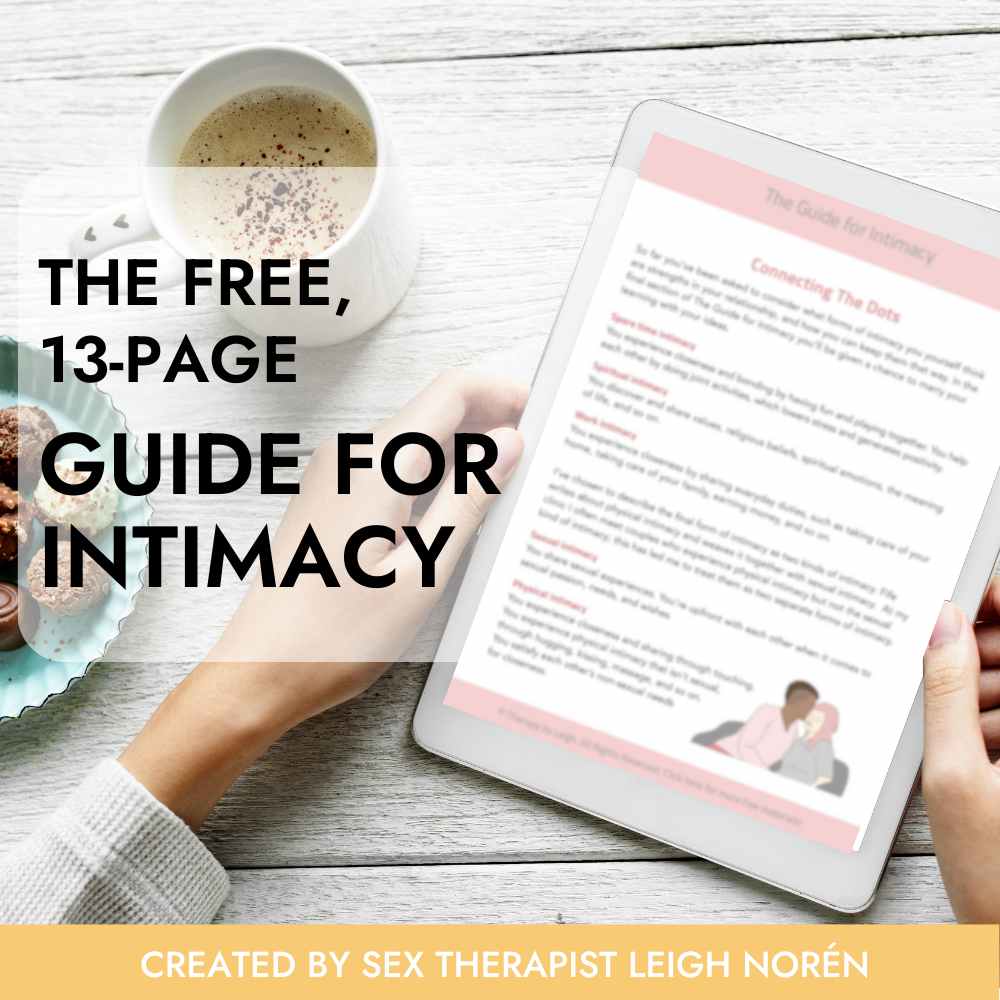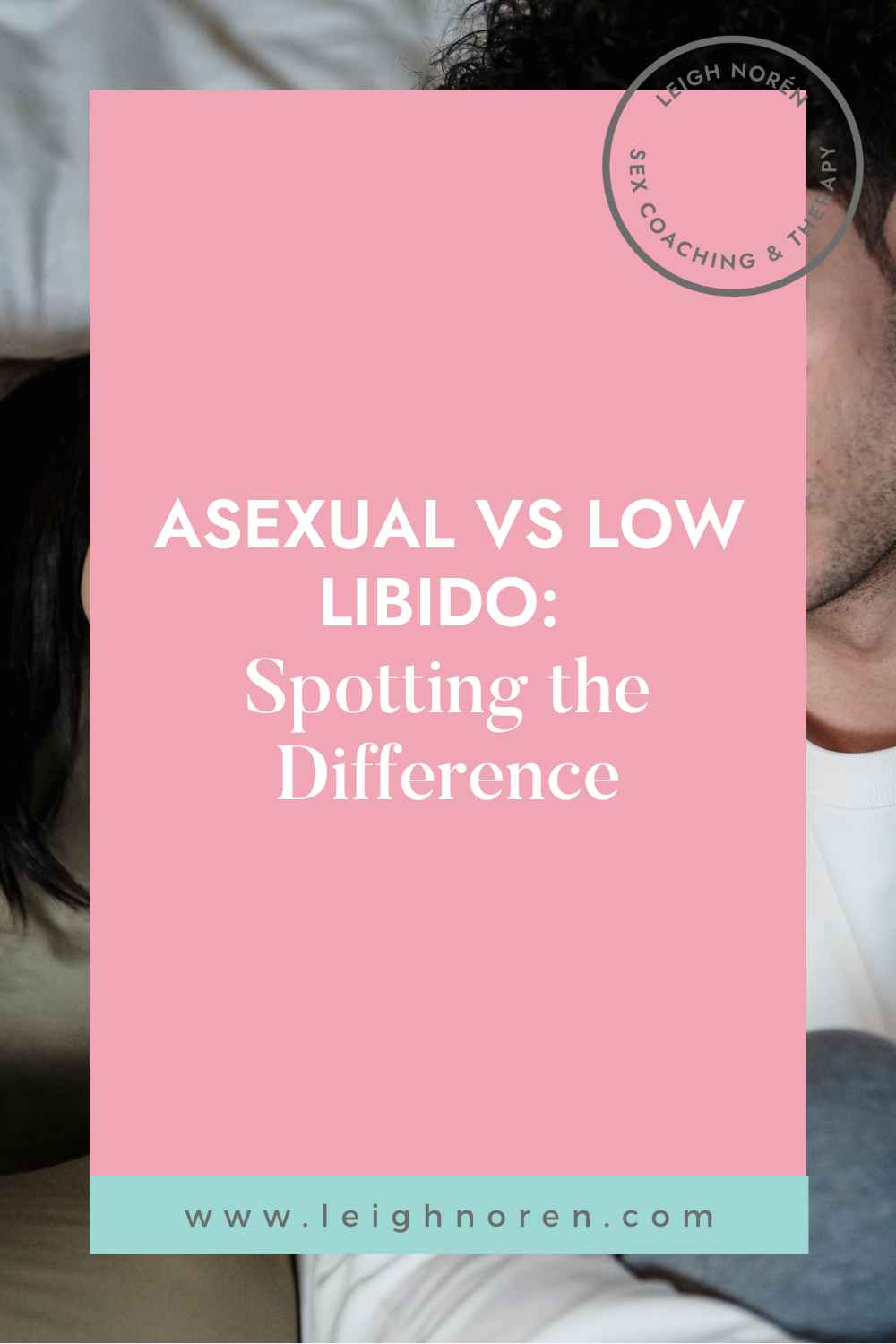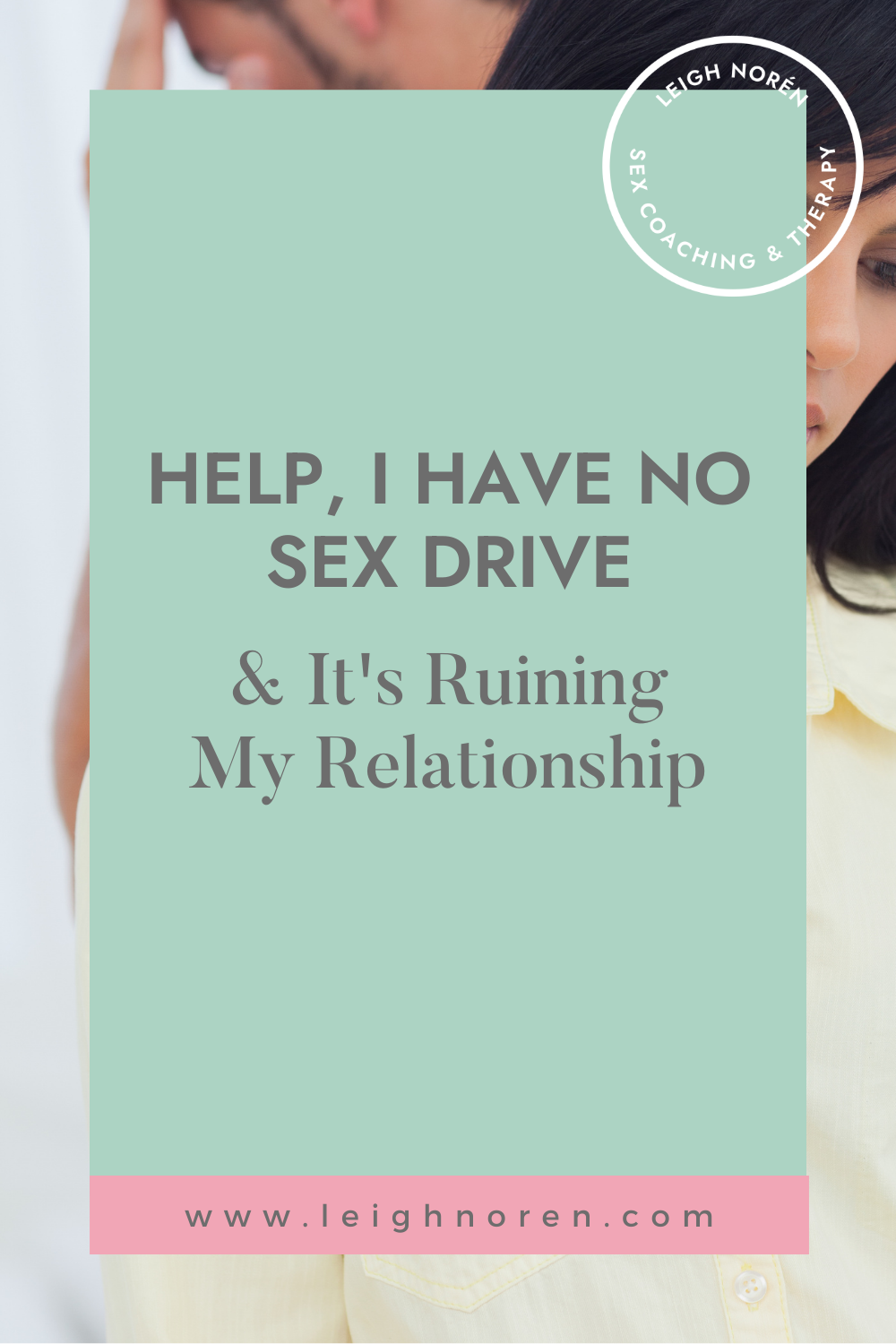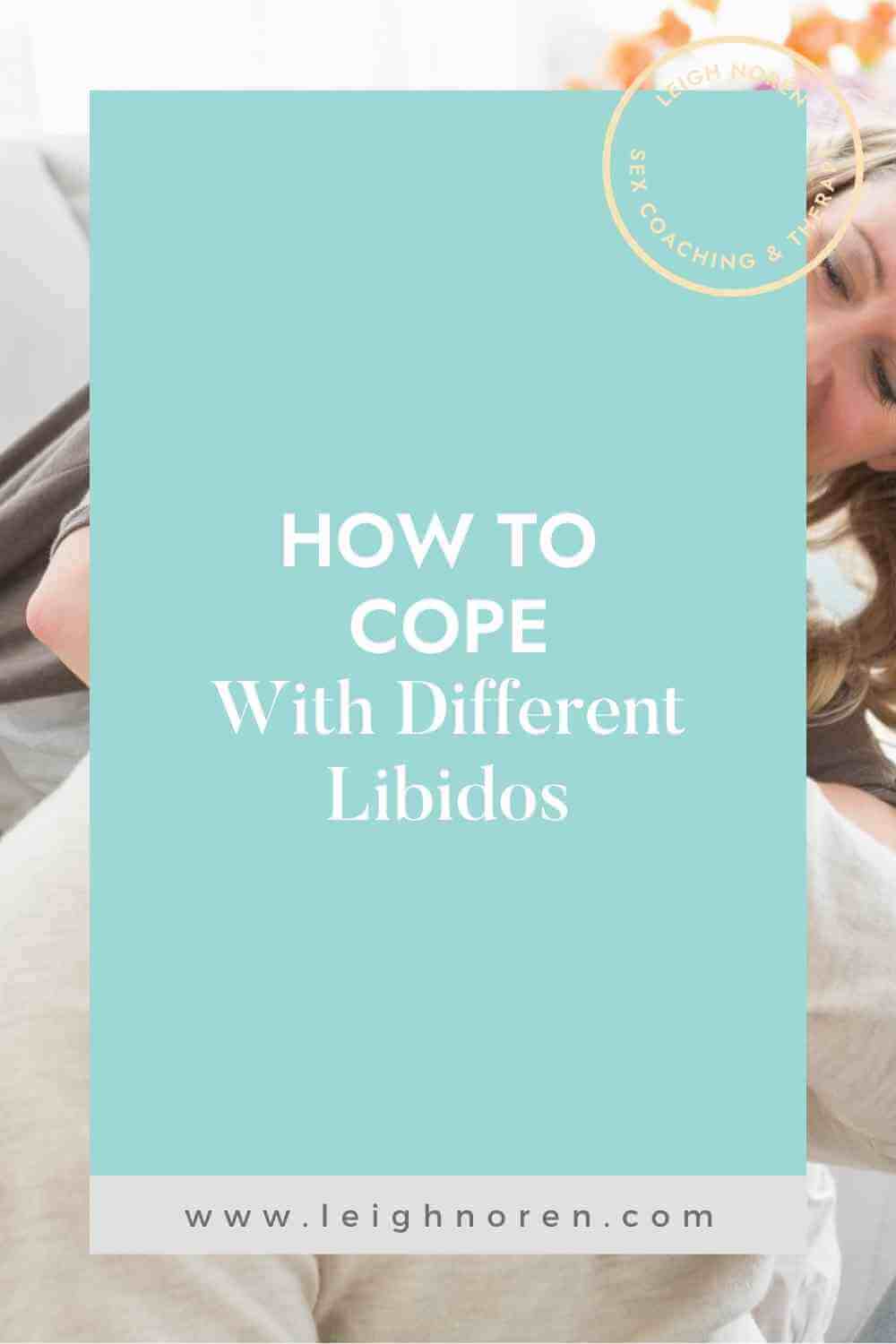Asexual vs Low Libido: Spotting the Difference
11 minute read
Does the prospect of sex feel completely uninteresting to you? Or maybe you find you’re constantly asking yourself, “Why am I never horny?” If so, you might just be asexual – or have a low sex drive.
In this blog post, we’re talking all about the asexual vs low libido conundrum.
We’ll address what asexuality is, what low libido is, and how to spot the difference. As a sex therapist specializing in low desire, I can tell you there are differences – but they’re not always clear-cut.
And the differences matter, because they have a deep impact on our well-being, our relationships, and the choices we make in life.
Because if you’re in a long-term relationship or marriage, low libido means you can increase desire or get it back. However, asexuality might mean you never want sex. If you haven’t discussed this before settling down together – it makes sense this distinction can have huge ramifications for both you and your partner.
So, let’s start by digging into signs you’re asexual and signs of low libido in order to make sense of it all.
In this article
Signs you’re asexual
Just like so many other things in life, asexuality is complex. It encompasses a whole host of variations and, for that reason, is often referred to as more of a spectrum than one way of being.
For instance, you might feel:
- A lack of sexual attraction to others
- Reluctant to include others in your own sexuality through partner sex (but regularly engage in masturbation and fantasy)
- A lack of desire and interest in sex (both the act but also the subject at large)
- You identify as asexual based on your relationship with sex and how you experience it
- You might even view your asexual identity as fluid. This means at times in your life you identify as asexual and at others, you don’t. But this one is tricky – so let’s come back to it in a bit!
So, if I don’t sleep with my partner, am I asexual?
Well – it depends. Because lots of people who aren’t asexual go through periods in life when they don’t have sex nor masturbate. But for some who identify as asexual, sleeping with their partner is something they engage in regularly – just not for sexual purposes.
For them, having sex is about other things entirely. This might be for relaxation purposes, wanting to experience physical closeness, or wanting to meet their partner’s needs.
Does trauma make people asexual?
No, it doesn’t. Trauma (even the sexual kind) doesn’t make people asexual.
Sexual trauma can and does often have an effect on our sexuality though. This includes things like feeling disgusted by sex, experiencing sexual anxiety, low desire, difficulties with arousal and orgasm, and low sexual self-esteem.
So, if you’ve experienced trauma in the past, it’s no wonder you may be considering whether trauma has “turned” you asexual when there’s nothing even remotely appealing about it anymore.
But sexual pleasure and sexual desire can be restored even after things like sexual assault. If you wish for it back.
This leads me to my third point…
There is nothing wrong with being asexual
Asexuality is much like any other sexual identity – it’s a way of being that just is. It doesn’t hinge on any traumatic events or anything being “wrong”.
However, in our sex-focused culture, asexuality is often seen as simply a phase – or a sign something is wrong with someone.
Other prejudices involve: the belief that asexual people cannot fall in love, are emotionally “different”, never can or want to have sex, or that they simply haven’t had good enough sex yet..
But the truth of the matter is, you can be asexual and still fall in love.
You can be asexual and have intimate, satisfying relationships.
And you can be asexual and feel good about your identity.
DO YOU WANT TO GET CLOSER TO YOUR PARTNER?

My free resource The Guide for Intimacy gives you access to tools that help you increase the shared intimacy in your relationship – with or without sex.
Download the 13-page guide and you also get access to my deeply appreciated, weekly newsletter. You can unsubscribe at any time.
Asexuality is a spectrum
There are lots of ways to identify as asexual – some of these include:
Asexual Aromantic
This means you neither feel sexual attraction or romantic attraction towards others.
Asexual Homo- Hetero- Biromantic
This means you feel romantic and emotional attraction to people of the same or other genders, but you still identify as asexual.
Demisexual
This means you only feel attraction and an interest in sex once you’ve formed an emotionally intimate bond with someone.
Grey-A
This means your asexual identity isn’t set in stone – it changes over time where you move along the scale between asexual and sexual.
Signs of low libido
Low or non-existent libido is a diagnosis, just like depression and anxiety. This means, unlike asexuality, low sex drive is more of a temporary state that can be changed if so desired.
To fulfill the criteria for the diagnosis, you need to experience things like:
- A lack of sexual fantasies and thoughts
- A lack of interest in sex
- A lack of or reduced sexual activity (with a partner or yourself)
- A lack of or lowered enjoyment of sex
- A lack of or lowered interest in sex
In order to get this diagnosis, you need to have experienced some of the above for a period of at least 6 months, and it needs to also cause you significant distress.
However – it also cannot be better explained by something else, such as identifying as asexual.
The thing about diagnoses, though – for all the good they do, ensure funds for important research, and lead to treatment plans that help millions – they’re also incredibly stigmatising.
As a sex therapist and intimacy coach I actually steer away from these labels as much as I can. Because at the end of the day, there’s nothing wrong with not desiring sex. You’re not broken if you don’t want or desire sex. Putting this kind of label on someone can sometimes do more harm than good.
Asexual or low libido: the main differences
Now you know some signs of low libido and some signs you’re asexual – let’s dig into the specifics that differentiate the two.
Low libido is temporary – asexuality is usually not
As mentioned previously, while asexuality doesn’t have to be permanent (for instance if you’re Grey-A) – a lot points to it being more stable than not.
A recent study aiming to understand the stability of the asexual identity found that it’s a pretty stable identity. The authors write: “Approximately 83% of asexual and gray-asexual individuals maintained their sexual orientation identity between two adjacent waves (….) The current findings indicate the relative stability of asexuality, which supports the notion that asexuality could be deemed a fourth sexual orientation.”
This would suggest being asexual isn’t a phase or something that will “blow over”. Rather, an identity like any other.
However, as mentioned in the paper Beyond sex: A review of recent literature on asexuality, the author suggests: “Asserting stability as necessary for the legitimacy of a sexual orientation, however, is inconsistent with other research that suggests that asexual identity and identification may be complex, circuitous, and fluid [2,13]”
So, how do we make sense of this?
Well, as asexuality isn’t a diagnosis, and low libido is, it’s very much about your experience. Whether you identify as asexual or not.
But if we’re looking at the larger picture – it’s more likely you’re experiencing low or non-existent sex drive if you’ve had desire and experienced attraction in the past.
And this could have been 6 months ago, but also 10 years ago.
A lot of the clients who seek me out have experienced a loss of desire and arousal for a long period of time. But the difference is that they remember a time when they did feel attraction and desire (even if it might not have been significant or as strong as their romantic partner’s).
Low libido can be changed – asexuality cannot
Asexuality is a sexual identity, meaning even if not everyone in the asexuality community feels it’s static – most do. In fact, this is generally seen as a requirement for an orientation, that it’s unchangeable.
This means, if you identify as asexual, no amount of therapy is going to change that. And it shouldn’t either.
Just as conversion therapy for homosexuality is (of course) abuse – so is any kind of therapy deemed trying to change someone asexual.
Low or non-existent libido, however, implies you can change things. You can start to feel interested in sex again, excited by the idea, and enjoy and revel in the pleasure it brings.
Asexuality can feel comforting – low libido seldom does
While a sexual desire disorder can feel comforting, it can also feel stigmatising and stressful. Because a diagnosis inherently means something is wrong and “needs” fixing. Even if I, personally, in my practice as a sex therapist don’t believe low libido ever needs fixing unless you want to try and fix it yourself.
Asexuality can often feel like coming home; like you’ve found a community of people who really get it. Conversely, some are asexual and still wish they felt differently about sex.
But even here, there are nuances because how you feel about your lack of desire and lack of a sex life is often closely linked to how your partner feels about it, too (if you’re in a relationship).
If you’ve been experiencing mismatched libidos for a long time, it’s bound to feel distressing, even if you might feel like you could go your whole life without sex and be fine.
Mini-exercise to work out what’s going on
By now, you know spotting the difference between being asexual and having low libido is a little tricky.
To help, I’ve compiled a list of questions to ask yourself to work out what’s going on. While a sex therapist can help you make sense of this – you’re the only one who can truly know.
Questions to help you understand if it’s low desire or asexuality:
Have you always felt an absence of desire, sexual attraction, or interest in sex?
If yes, you might be asexual.
How do you feel about your lack of interest in sex and lack of sexual attraction to others? Are you happy with this or would you like to feel more desire or attraction to others?
- If you want to feel differently, is it due to wanting to avoid the negative consequences of not being interested in sex?
For example, that your partner would prefer you not to be asexual or that not being asexual would help you feel like “everyone else”? Or do you feel a longing somewhere deep within to express your sexuality in a way that feels right for you? A way you might never have done before?
Would you feel content going the rest of your life without sex and feeling sexually attracted to others?
This is something I’ve heard time and time again in my practice – both from those who are asexual and those who have low libido or no sex drive.
- If this feels like you, ask yourself: is this because my partner and I are in a rut where I feel extreme pressure and stress to have sex? If so, feeling like you could go forever without it wouldn’t be strange at all.
But it would be a reaction to the pressure, fights about sex, and the pursuer-distancer cycle you might be in – rather than a question of being asexual.
It could also be related to a particularly stressful period in life, like raising children. During this time with littles, a lot of people (especially mums) find it hard to separate their mum identity from the rest of themselves. And being mum isn’t exactly tied to erotic feelings.
If you’re never given the chance to separate your identity from that as your child(ren’s) caregiver – it might feel like you’re miles away from your sexuality, and things will never change. But they can(!), if it’s low libido.
If you could take sex at your own pace and set the rules completely (including what you do and don’t do sexually and how it’s initiated) without pressure from a partner, would it feel different?
If yes, it’s likely low libido.
If sex was like your sexual fantasies or like when you masturbate, would you feel different?
If yes, it’s probably low libido.
If you knew sex wouldn’t create any conflict or pressure, or hard conversations – would you feel differently?
If yes, it’s, again, likely low libido.
Your main takeaways on the differences between asexuality and low sex drive
It can be difficult to distinguish between whether you’re asexual or have run into a rough patch with your sex drive. Especially when we’re constantly bombarded with societal norms about how we “should” be and feel about sex.
At the end of the day, asexuality is an identity, just like any other. This means the only person who gets to decide whether it rings true for you – is you – not a partner, not a therapist – you.
While asexuality, for the most part, seems to be stable, some find it can fluctuate throughout life.
However, some of the biggest differences between low desire and asexuality are that it’s likely to be low libido if you’ve previously experienced desire and attraction in the past (even if it’s years or decades away).
This is perhaps especially true if your low desire is also explained by other things. Stuff like mismatched levels of libido in your current or previous relationships and the toll it’s taken on you. Or if you’ve been subjected to sexual trauma of any kind.
It’s important to remind yourself that you know yourself and your needs best.
Regardless of whether you identify as asexual or are going through a period where your sexual desire is not where you want it to be – you get to be who you are.
And if you decide you do want to do something about it; because part of you knows deep-down sex has been pleasurable in the past, or made you feel extra connected to your partner, or the sexual attraction you’ve felt to strangers lights you up and gives you energy – I’m here to help.
My on-demand sex drive course Re:Desire helps you get your sex drive back.
All without wacky sex positions, scheduling sex, or pressure.
It’s a 9-month course based on my proprietary method “The 5 Phases to Stress-Free Sex & Intimacy” that helps you access your desire for more and better sex (on your terms).

Zero sex drive?
You’re not alone! Download the 10-page Desire Test to find out why your desire for sex is gone (and what to do about it).
Questions based on a variety of factors proven to negatively affect desire
Find out which factors are responsible for your low or non-existent sex drive
Get instant access to expert advice, delivered directly to your inbox when you download The Desire Test. Unsubscribe anytime.
WANT TO KNOW MORE ABOUT THE DESIRE TEST?
With 9 years of experience as a sex therapist and coach - Leigh helps her clients create stress-free, shame-free, pressure-free sex lives, through her unique combination of sexological science, & psychotherapeutic & coaching tools.
OTHER POSTS YOU MIGHT ENJOY
Copyright © 2019-2025 Leigh Norén. All Rights Reserved. | Website by Pinegate Road
Cookie policy | Terms & Conditions | Privacy Policy


